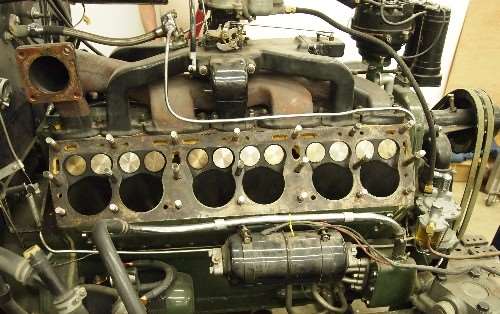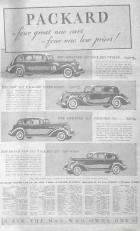|
Re: Packard 446/473 V12
|
||||
|---|---|---|---|---|
|
Home away from home

|
A comment as made above at 17:06:26 about the Su8 out performing the V12??? I'm not the least bit familiar with the Packard 8 or 12 but i find that statement very difficult to believe. Especialy in view of the 400++ cid.
On the otherhand, the 12's and 16's of ANY mfg'r was, in the J.Q.Public view, simply a nonissue. Rightfully so. Seriously, how much better is the 12 or 16 of ANY mfg'er than the 8 or V8 of ANY mfg'er???? Certainly the 8's (straight OR V) has terrific advantage over 6's and especialy 4's. But anything much over 8 cylinders simply becomes an over embellishment.A bad case of bragging rights and little more.
Posted on: 2015/2/4 20:47
|
|||
|
VAPOR LOCK demystified: See paragraph SEVEN of PMCC documentaion as listed in post #11 of the following thread:f
packardinfo.com/xoops/html/modules/newbb/viewtopic.php?topic_id=7245 |
||||
|
||||
|
Re: Packard 446/473 V12
|
||||
|---|---|---|---|---|
|
Forum Ambassador

|
In the "great showdown" to crown the new 356 Super Eight of 1940 as the king over the aged Twelve, whether anything was rigged, in terms perhaps of gearing or choice of body styles and weights, we'll never know but regardless, the era that spawned these cars an their magnificent coachwork was over. Tastes of the wealthy had changed and engineering had improved to where far cheaper-to-make engines with lesser cylinders could give comparable or nearly comparable performance and advances in motor mountings and better understanding of balance and engine vibration that gave competitive or at least acceptable smoothness to engines with fewer cylinders.
John, if you are really interested in engine designs there is IMO perhaps no period in automotive history, here or abroad, that gives as much to appreciate and study as the luxury and near-luxury makes from just before and into the depression years. In the decidedly middle-class car, Auburn with it's Lycoming-designed and made V12 was a fine design and lived on, like the Pierce Arrow Twelves, to find several decades of further use in fire engines, LaFrance in the case of the Auburn engine. And an Auburn closed car Twelve cost less than half of a Packard Standard Eight sedan! Slightly upscale but still middle-class, Franklin thought their salvation was in a Twelve, air-cooled of course, and first planned in no less than 3 displacements - for what - a couple of hundred cars. Though not to disregard the later K series that followed, Lincoln's pinnacle was almost certainly the magnificent KB series of 33/34 with their elegant fork and blade connecting rods; what a fall from grace to later introduce the puny and flawed little Zephyr and Continental V12. We've already talked about Pierce-Arrow, consider the many AAA performance records they set with the likes of Ab Jenkins driving. Though the Cadillac V12 and V16 were of nearly obsolecent design just a year or two after they were introduced, they were magnificent as well, probably smoother than any of it's competitors. Even Rolls-Royce got on the bandwagon with their V12 though it never developed the reputation for reliability that it's American counterparts did. Arguably the most outstanding from an engineering and horsepower standpoint was the Marmom V16 with an astoundingly complex one-piece cast alloy crankcase and wet sleeves. Even among those that couldn't afford a new "V configuration, Stutz's SV 16 and DV 32 overhead cam in-line 8 engines were superb. Ditto for the Duesenberg monster. I know almost nothing about the big 464 CI Peerless V16, only 1 built though happily it survives in Cleveland. All in all, great grist for those interested in such things and fortunately there is no shortage of information about these masterpieces. Each can be a fascinating study.
Posted on: 2015/2/4 23:21
|
|||
|
||||
|
Re: Packard 446/473 V12
|
||||
|---|---|---|---|---|
|
Home away from home

|
Here's some Packard engine weight data that the forum has discussed in one form or another over the last several years. All with clutch and transmission. Overdrive and Ultramatic excluded:
1934 320 I8: 1020 lbs 130 HP 7.85 lbs/HP 1934 385 I8: 1116 lbs 150 HP 7.44 lbs/HP 1934 445 12: 1320 lbs 160 HP 8.25 lbs/HP 1941 245 I6: 673 lbs 100 HP 6.73 lbs/HP 1941 282 I8: 781 lbs 120 HP 6.51 lbs/HP 1941 356 I8: 986 lbs 160 HP 6.16 lbs/HP 1954 288 I8: 860 lbs 150 HP 5.73 lbs/hp 1954 327 I8: 885 lbs 180 HP 4.92 lbs/HP 1954 359 I8: 876 lbs 212 HP 4.13 lbs/HP (aluminum cylinder head) One can see the power-to-weight efficiency gains that Packard made with each new generation, the One Twenty family of Sixes and Eights being an improvement and dual carbs helping the 1954s. The 445 V12 was an exception, being a newer engine than the 320 and 385 Eights yet less weight efficient. I recall seeing a table showing the Pierce V12 at 1200 lbs which, with 185 HP, would have given it an efficiency of 6.49 lbs/HP. But it is not known if the weight included the clutch and transmission. The famous "race" between the 1939 Twelve and 1940 Super Eight needs to factor in the weight difference of the body, the Twelve using Packard's older body architecture, which was at least 600 lbs heavier. This can be deduced from the weight difference between the 1938 and 1939 Super Eights, both on a 127" wb, the former using the old Senior body, the latter the all-steel Junior. This weight difference, as well as the added cost of such bodies and the outdated styling they presented, helped drag down sales of Packard, Pierce and Lincoln multicylinder flagships in the late 30s. The weight of Cadillac's new for 1938 V16 engine appears to have been around 240 lbs more than the marque's V8, which would have meant the added HP carried a 4.8 lbs/HP efficiency. Not bad for the period and perhaps an indication of what was possible had these companies continued to evolve their multicylinder engines. Cadillac's new V16's sales might have been hampered by cost more than anything. My guess is that it was manufactured on a low volume line with no intention on GM's part to do anything more than keep up with the competition until they vanished. I think a modern late 30s V12 with some attempt at producton efficiency would have been a good differentiator for a luxury marque until post-war high compression OHV V8s arrived.
Posted on: 2015/2/8 17:07
|
|||
|
||||
|
Re: Packard 446/473 V12
|
||||
|---|---|---|---|---|
|
Forum Ambassador

|
I just happened upon this photo which clearly shows the simaesed pairing as discussed earlier in this thread of the cylinders on the 445/473 Packard Twelve.
Posted on: 2015/2/12 13:43
|
|||
|
||||
|
Re: Packard 446/473 V12
|
||||
|---|---|---|---|---|
|
Webmaster
|
Dual Carbs in 1954? I think you mean 4bl Carbs?
Posted on: 2015/2/12 14:00
|
|||
|
-BigKev
1954 Packard Clipper Deluxe Touring Sedan -> Registry | Project Blog 1937 Packard 115-C Convertible Coupe -> Registry | Project Blog |
||||
|
||||
|
Re: Packard 446/473 V12
|
||||
|---|---|---|---|---|
|
Home away from home

|
Packard claimed 0 to 60 MPH in 13 seconds for the 1940 Su8.
That's around 2 seconds slower than 55 V-8. The Rolls PIII gets a bad rap. It actually would beat the Packard 12 in a stop light drag.
Posted on: 2015/2/12 16:55
|
|||
|
||||
|
Re: Packard 446/473 V12
|
||||
|---|---|---|---|---|
|
Home away from home

|
Thanks for correction BigKev.
13 sec in 1940, pretty good stuff. Manual trans helped.
Posted on: 2015/2/12 19:30
|
|||
|
||||
|
Re: Packard 446/473 V12
|
||||
|---|---|---|---|---|
|
Home away from home
|
Very good discussion.
Simply making V12's more powerful by bigger displacement definitely has some engineering issues. Besides heat removal, one is crankshaft harmonics/critical speed issues. Longer and more connections isn't nicer there. The air cooled radial 12's in airplanes made a bunch of HP. The Italians; Ferrari, Lambo, etc overcame these by going in the opposite direction; smaller displacement, alloy, higher revving, etc. They get better HP/wt and torque numbers with less displacement. So the fundamental direction of the question is linear based, not as it should be, i.e. how to efficiently make more HP in a V12?... So to directly address the first question, bigger wouldn't necessarily have been better. As noted, the Caddy V16 wasn't well received and there were many 400+ CI engines in the prewar. In the post war, higher compression ended alot of simple displacement gains, either diam or stroke. In the past, I noted, the L8 straight 8 288 CI ~7:1 made about 130 HP, vs a V8 of 360 CI 10.5:1 making 330+ hp and ~two thirds to almost half the weight developed in a space of less than ten years. What I've yet to see ferreted out is why they dropped the supercharger or turbocharger from autos in the 20's or left from further development? They kept them for industrial the whole time. I have some ideas but never seen any research/literature. It's guaranteed HP - multiplies displacement by pressure not dimension. So no need to increase bore and stroke, per se. The supercharger was revived in the 50-60's by dragsters and now the turbo's being rediscovered and the HP numbers can be off the chart HUGE. First tinkered with in the diesels pullers now back in gas and racing. What goes around...
Posted on: 2015/2/12 22:03
|
|||
|
||||
|
Re: Packard 446/473 V12
|
||||
|---|---|---|---|---|
|
Home away from home

|
As to why superchargers never took off, my guess would be noise/vibration/harshness, durability, cost and complexity.
Have never researched turbos. Earliest recollection are the Seventies... Saab, Porsche, M-B and Buick. They were mainly sold as a performance feature. Today they are still used as such but also for fuel economy. Did the tech exist in the Twenties and Thirties to make them reliable?
Posted on: 2015/2/14 7:41
|
|||
|
||||


 (126.71 KB)
(126.71 KB)






